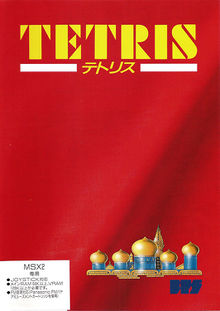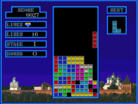Tetris (BPS): Difference between revisions
No edit summary |
Rephrase for better grammar. And remove editorializing |
||
| Line 52: | Line 52: | ||
Programmed by Takashi Sakamoto. The programmer left a developer message referencing JoJo's Bizarre Adventure. | Programmed by Takashi Sakamoto. The programmer left a developer message referencing JoJo's Bizarre Adventure. | ||
This version doesn't correct for CPU clock speed; emulators should be set to 10MHz for correct performance. | |||
=== X1 (1989) === | === X1 (1989) === | ||
Revision as of 16:01, 19 October 2020
| Tetris | |
|---|---|
 | |
| Developer(s) | Bullet Proof Software |
| Publisher(s) | Bullet Proof Software |
| Platform(s) | PC-8801, PC-88 VA, PC-9801, X1, X68000, FM-77, FMR, MSX2 |
| Release |
|
| Gameplay info | |
| Next pieces | 1 |
| Playfield size | 10 × 20 |
| Hold piece | No |
| Hard drop | Hard only |
Tetris, developed by Bullet-Proof Software, was the first licensed game to be released commercially in Japan. It was released on most of the common home computers from the era.
A Famicom port was released in December, 1988.
Gameplay
The game is split into six rounds of ten stages. Drop speed increases with each stage, while each round starts with higher amounts of garbage. Each stage is completed after 25 lines are cleared, after which the playfield is reset.
The player has three lives. Topping out will cost the player a life.
Scoring
Line clears are scored as follows:
| Line clear | Points |
|---|---|
| 1 (single) | 40 |
| 2 (double) | 100 |
| 3 (triple) | 300 |
| 4 (tetris) | 1200 |
If the piece was hard dropped, an amount equal to the number of rows covered by the hard drop plus 1 is added. Otherwise, no score for dropping is added.
Points are only totalled up either after the stage is cleared or if a life is lost.
Versions
PC-8801
PC-88 VA
Programmed by Richard C. Rogers.
PC-9801
Programmed by Richard C. Rogers.
X68000
Programmed by Takashi Sakamoto. The programmer left a developer message referencing JoJo's Bizarre Adventure.
This version doesn't correct for CPU clock speed; emulators should be set to 10MHz for correct performance.
X1 (1989)
Programmed by Yoshiharu Kawai.
MSX2
Programmed by Tomokazu Hasegawa.
FMR50 (1988-1989)
Programmed by Takashi Sakamoto.
FM-77 AV
Programmed by Yoshitaka Yamamura and Tatsuya Kitamura.
External links
| ||||||||

